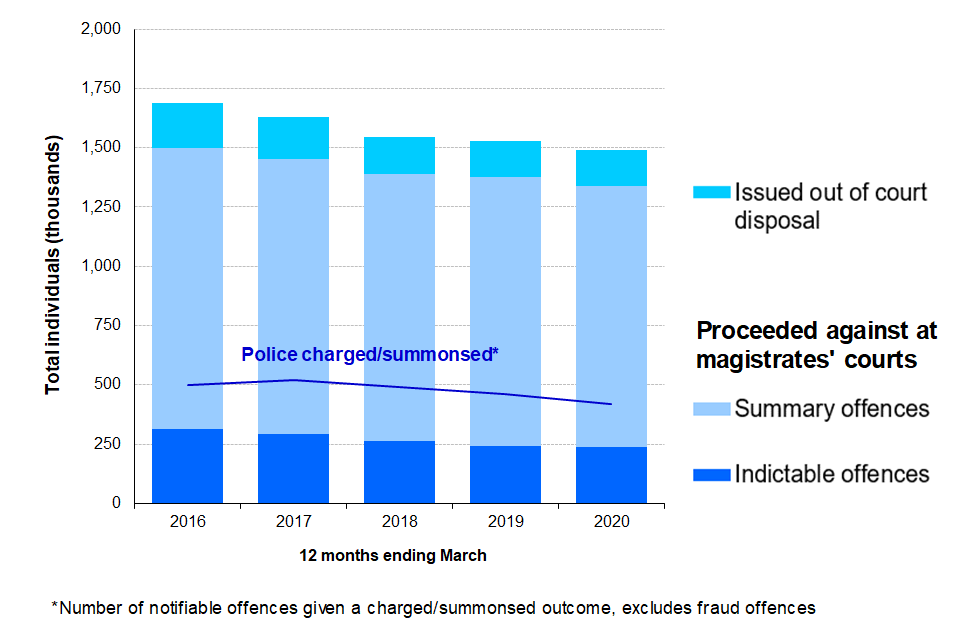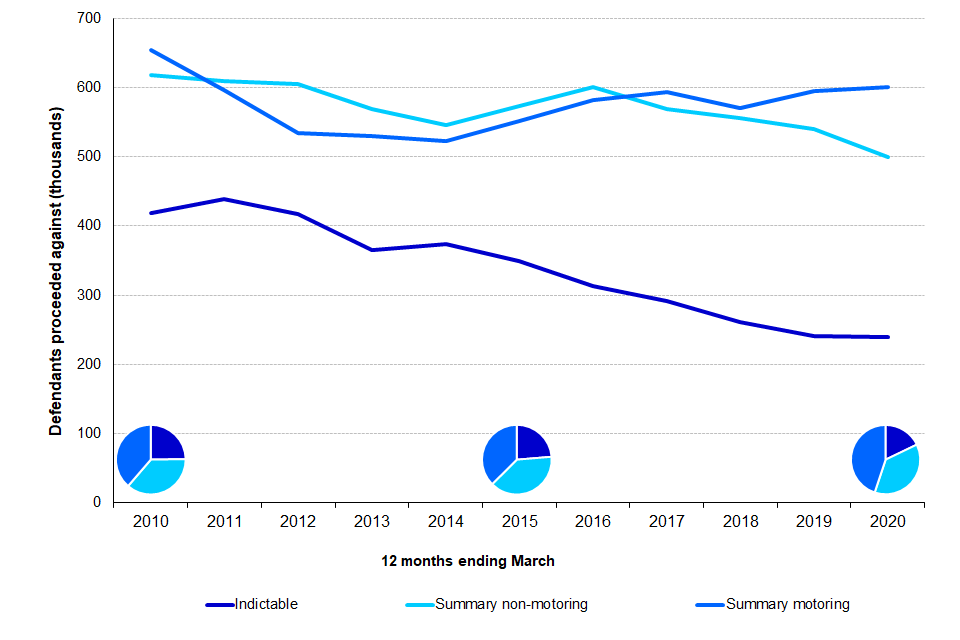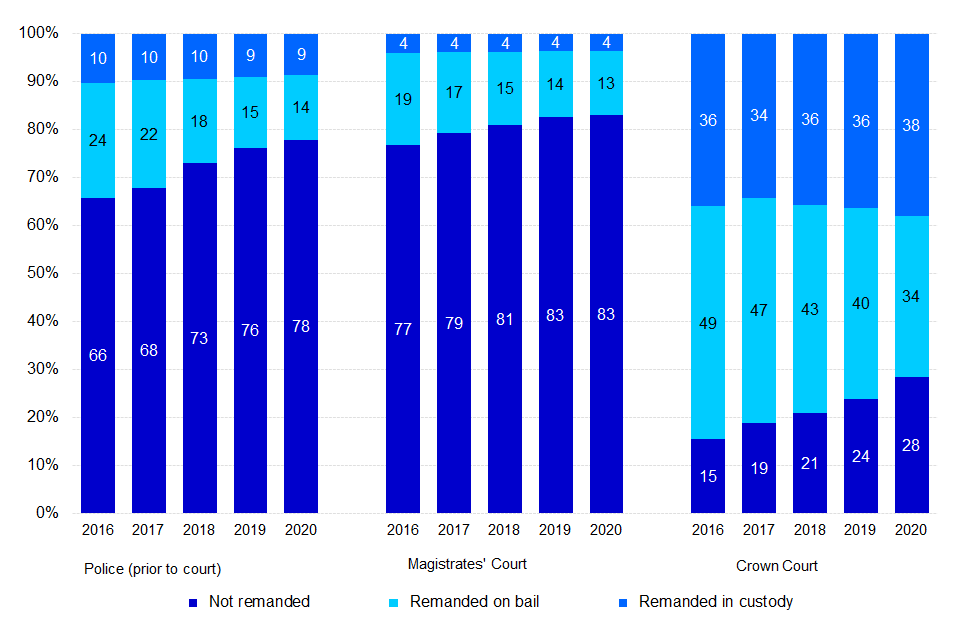Criminal Justice Statistics quarterly: March 2020
Published 20 August 2020
Applies to England and Wales
We are trialling the publication of this statistical bulletin in HTML format alongside the usual PDF version and we are seeking user feedback on the use of HTML for the publication of statistical bulletins. Please send any comments to: datausers@justice.gov.uk.
Main Points
| 1.49 million individuals have been dealt with by the CJS (excluding cautions). | The total number of individuals formally dealt with by the criminal justice system (CJS) in England and Wales has declined since 2016 and fell 2% in the latest year when excluding cautions. |
| The number of defendants prosecuted at magistrates’ courts fell by 3% to 1.34 million in the latest year. | The volume of prosecutions fell across most offence groups, although those for sexual offences, robbery and drug offences increased. Convictions fell at a similar rate. |
| The number and proportion of defendants remanded on bail has continued to fall. | The number of defendants remanded on bail decreased in the latest year by: 11% by the police, by 6% at magistrates’ court, and 15% at Crown Court. |
| The average custodial sentence length was the highest in the decade at 19.6 months. | The average custodial sentence length has increased across most offence groups over the latest year, to 22.2 months for indictable offences and 2.7 months for summary offences. |
This publication gives criminal justice statistics for the latest 12 month period. These are presented alongside the same 12 month period for the previous years where available, giving longer-term trends across comparable periods. The figures in this report are subject to change prior to the 2020 Criminal Justice Statistics annual bulletin, scheduled to be published on 20 May 2021, which will also contain full and detailed commentary. For technical detail please refer to the accompanying guide to criminal justice statistics.
Please note that the decision has been made to delay the offending histories and out of court disposals components of this publication. In line with guidance from the Office for Statistics Regulation, the COVID-19 pandemic has caused MoJ to have to change its data gathering, access and release practices, focusing efforts on priority analysis and statistics. In particular, we paused access to the Police National Computer, on which these components rely, to minimise non-essential travel by our analysts. We will keep users updated of any further changes via our published release calendar. We will be publishing a response to our February consultation on changes to the frequency and timing of the offending histories components, setting out when these will be published in the future.
Statistician’s comment:
The number of defendants prosecuted has fallen over the last decade and figures published today continue that trend, with a slight decrease in the year ending March 2020. The figures released today cover the period to the end of March 2020 and any COVID-19 impacts, for example on the level of prosecutions, are likely to be small[footnote 1].
There have been increases in prosecutions for some of the most serious offence groups in the latest year, in particular violence, drug offences, robbery and sexual offences. The increase in prosecutions and convictions for violence continue to be driven by the legislation that introduced the new offence of ‘assaults on emergency workers’ from November 2018, while the increases for other offences groups are driven by an increase in charges brought forward by the police.
The publication also shows the different pattern for custody rates across offences – with a continued increase in custody rates for the most serious, indictable, offences, alongside a reduction in rates for summary offences. Average custodial sentence lengths continue to rise and were the highest in a decade.
Although we often consider crimes to correlate with prosecutions, we would not expect prosecutions to move directly in line with the ONS published police recorded crime series, or Crime Survey for England and Wales as only those crimes that result in a charge are likely to flow into courts – in addition criminal court prosecutions cover a much broader range of offences than police recorded crime or the survey.
For feedback related to the content of this publication, please contact us at CJS_Statistics@justice.gov.uk
1. Overview of the Criminal Justice System
1.49 million individuals have been dealt with by the CJS (excluding cautions[footnote 2])
The total number of individuals[footnote 3] formally dealt with by the criminal justice system (CJS)[footnote 4] in England and Wales has declined since 2016 and fell 2% in the latest year when excluding cautions.
Figure 1: Individuals dealt with formally by the CJS[footnote 5] [footnote 6], offences resulting in a police charge/summons, 12 months ending March 2016 to March 2020 (Source: Tables Q1.1 and Q1.2)

Individuals dealt with formally by the CJS, offences resulting in a police charge/summons, 12 months ending March 2016 to March 2020
The number of individuals formally dealt with by the CJS fell by 2% in the latest year. The number of individuals prosecuted at all courts fell by 3% overall and by 1% for indictable offences. A decrease was also seen in the number of offences resolved with a charge in the latest crime outcomes statistics published by the Home Office. These fell by 6% in the latest year to 415,000[footnote 7]. This is despite a 1% increase in overall recorded crime (to 5 million offences excluding fraud[footnote 8]), believed to be associated with improved recording among police forces and victims’ greater willingness to report crimes. Around two thirds of prosecutions are brought to court by prosecuting authorities other than the Police.
The Crime Survey for England and Wales (which estimates personal experiences of crime) estimated 5.7 million incidents of crime in the year ending March 2020 (excluding fraud and computer misuse), a 12% decrease compared with the previous year[footnote 9].
2. Out of Court Disposals
The release of this quarter’s cautions data is delayed, as the Ministry of Justice’s data extract of the Police National Computer, on which these components rely, has been paused to minimise non-essential travel by our analysts. We will keep users updated of any further changes via our published release calendar. A separate series on cautions issued by the police for notifiable offences is published by the Home Office and is available in their Crime Outcomes data tables.
Out of court disposals (OOCDs) are sanctions used by the police to address offences without the need to be dealt with at court. Excluding cautions, there were 151,000 OOCDs in the year ending March 2020, which has remained stable when compared to the previous year, with an increase in community resolutions offsetting reductions in cannabis/khat warnings and penalty notices for disorder. The long-term downward trend in the number of OOCDs followed a number of policy changes relating to police practice and OOCD availability[footnote 10].
Figure 2: Out of court disposals issued (excluding cautions) by disposal type, England and Wales, 12 months ending March 2016 to 2020 (Source: Tables Q.1.1 & Q2.1)

Out of court disposals issued (excluding cautions) by disposal type, England and Wales, 12 months ending March 2016 to 202
The use of Penalty Notices for Disorder (PNDs) continued to decline, by 10%, with 19,000 issued in the latest year. The most common offences that resulted in a PND were drunk and disorderly, possession of cannabis, causing harassment, alarm or distress, and theft (under £100). Together these offences accounted for 92% of all PNDs issued.
In the latest year, there was a 5% increase in the use of community resolutions and a 17% decrease in the use of cannabis/khat warnings.
3. Court Proceedings and Convictions
The number of defendants prosecuted at magistrates’ courts fell by 3% to 1.34 million in the latest year.
The volume of prosecutions fell across most offence groups, although those for sexual offences, robbery and drug offences increased. Convictions fell at a similar rate.
Figure 3: Defendants prosecuted at magistrates’ courts, 12 months ending March 2010 to March 2020, by type of offence (Source: Table Q3.2)

Defendants prosecuted at magistrates' courts, 12 months ending March 2010 to March 2020, by type of offence
Compared to the previous year, the 3% fall in prosecutions was mainly driven by an 8% decrease in summary non-motoring offences, which accounted for 37% of prosecutions overall.
Prosecutions for indictable offences decreased by 1%, mainly driven by a 15% fall in theft offences which accounted for the largest proportion (26%) of indictable offences. There was a 20% increase in violence against the person prosecutions, driven by legislation on assaults on emergency workers which came into effect in 2018[footnote 11], and smaller increases for drug offences (11%), robbery (9%) and sexual offences (6%).
There were 1.16 million offenders convicted in the year ending March 2020, a 3% decrease on the previous year. As was seen in prosecutions, this was driven by a 7% fall in convictions for summary non-motoring offences, which accounted for 37% of convictions overall. Convictions for indictable offences fell by 1%, mainly driven by a 15% fall in theft offences (accounting for 27% of indictable offences), this was offset by a 12% increase in convictions for drug offences (accounting for 20% of indictable offences). The number of convictions for violence against the person offences increased by 21% in the latest year, which is in line with the increase seen in prosecutions for these offences.
4. Remands
The proportion of defendants remanded on bail has continued to fall.
The number of defendants remanded on bail decreased in the latest year by: 11% by the police, by 6% at magistrates’ court, and 15% at Crown Court.
In the year ending March 2020, 1.40 million defendants were directed to appear at magistrates’ courts (including those who failed to appear). Over the last 5 years, the proportion of defendants summonsed (not remanded) prior to appearing at magistrates’ court steadily increased to 78%, the proportion arrested and bailed by the police[footnote 12] steadily decreased to 14% over the same period. The proportion remanded in custody by the police remained broadly stable and was 9% in the year ending March 2020.
At Magistrates’ court, the proportion of defendants granted bail decreased steadily to 13% over the last 5 years, while the proportion of defendants not remanded increased to 83%. The proportion of defendants remanded in custody remained stable at 4%. At Crown Court, the proportion of defendants not remanded increased steadily to 28% while the proportion of those remanded on bail decreased to 34%. The proportion of defendants who were remanded in custody increased over the last 4 years and was 38% in latest year.
Figure 4: Defendants’ remand status with Police (prior to court), at magistrates’ courts and at Crown Court, year ending March 2016 to year ending March 2020 (Source: Table Q4.1, Q4.2 and Q4.3)

Defendants’ remand status with Police (prior to court), at magistrates’ courts and at Crown Court, year ending March 2016 to year ending March 2020
In the latest year, of the defendants remanded in custody at magistrates’ courts, 13% were sentenced to immediate custody, and a further 65% were sent for trial or sentencing at Crown Court. Of those remanded in custody at Crown Court, 76% were sentenced to immediate custody. Of all defendants who were not remanded at Crown Court, 50% received an immediate custody sentence.
5. Sentencing
The average custodial sentence length was the highest in the decade at 19.6 months.
The average custodial sentence length has increased across most offence groups over the latest year, to 22.2 months for indictable offences and 2.7 months for summary offences.
Compared to the year ending March 2019, the overall number of offenders sentenced at all courts fell by 3% to 1.16 million. This was driven by a decline in summary non-motoring offences, which decreased by 7%. Fines remained the most common sentence, accounting for 78% of all sentences in the latest year, an increase of 6 percentage points in the last five years. Of all offenders sentenced in the latest year, 7% received a community sentence, 7% immediate custody, 3% a suspended sentence, and 3% were given a conditional discharge. A greater proportion of offenders (33%) received immediate custody for indictable offences than any other sentence outcome, up by 1 percentage point in the latest year.
Figure 5: 1-year and 5-year percentage change for offenders sentenced at all courts to immediate custody, by offence type (Source: Table Q5.2a)

1-year and 5-year percentage change for offenders sentenced at all courts to immediate custody, by offence type
The average custodial sentence length was the highest in the decade at 19.6 months, an increase of 2.3 months from the previous year. Across all offence types, the number of defendants given an immediate custodial sentence shorter than six months was 34,900. This was 10% fewer than in the year ending March 2019, having continually decreased since 2012. There was a 24% increase in offenders sentenced to immediate custody for drug offences compared to the year ending March 2019, up to 9,500, the highest since 2012.
The decrease in offenders sentenced to immediate custody for summary non-motoring offences in the latest year drove the 21% decrease in custodial sentences for all summary offences.
Further information
The data presented in this publication are provisional. Final data for each calendar year is published in May each year in our Criminal Justice Statistics annual bulletin, following further data cleaning and the incorporation of additional cases not available in our original extracts of administrative data.
Accompanying files
As well as this bulletin, the following products are published as part of this release:
-
A technical guide providing further information on how the data is collected and processed, as well as information on the revisions policy and legislation relevant to sentencing trends and background on the functioning of the criminal justice system.
-
A set of overview tables, covering each section of this bulletin.
National Statistics status
National Statistics status means that official statistics meet the highest standards of trustworthiness, quality and public value.
All official statistics should comply with all aspects of the Code of Practice for Statistics. They are awarded National Statistics status following an assessment by the Authority’s regulatory arm. The Authority considers whether the statistics meet the highest standards of Code compliance, including the value they add to public decisions and debate.
It is the Ministry of Justice’s responsibility to maintain compliance with the standards expected for National Statistics. If we become concerned about whether these statistics are still meeting the appropriate standards, we will discuss any concerns with the Authority promptly. National Statistics status can be removed at any point when the highest standards are not maintained, and reinstated when standards are restored.
Future publications
Our statisticians regularly review the content of publications. Development of new and improved statistical outputs is usually dependent on reallocating existing resources. As part of our continual review and prioritisation, we welcome user feedback on existing outputs including content, breadth, frequency and methodology. Please send any comments you have on this publication including suggestions for further developments or reductions in content.
Contact
Press enquiries should be directed to the Ministry of Justice press office:
Tel: 020 3334 3536
Email: newsdesk@justice.gov.uk
Other enquiries about these statistics should be directed to the Justice Statistics Analytical Services division of the Ministry of Justice:
Damon Wingfield, Responsible Statistician and Head of Criminal Justice System Statistics
Ministry of Justice, 3rd Floor, 10 South Colonnade, London, E14 4PU
Email: CJS_Statistics@justice.gov.uk
Next update: 12 November 2020
URL: https://www.gov.uk/government/statistics/criminal-justice-system-statistics-quarterly-march-2020
© Crown copyright Produced by the Ministry of Justice
Alternative formats are available on request from ESD@justice.gov.uk
-
For more information about COVID-19 impacts on courts, see the HMCTS regular management information publication: https://www.gov.uk/government/collections/hmcts-management-information ↩
-
Cautions have been excluded due to the Ministry of Justice’s data extract of the Police National Computer being inaccessible in line with the COVID-19 guidelines and regulations around social distancing and travel. ↩
-
A single individual (includes people and companies) can be counted more than once in a year if they are dealt with by the CJS on more than one occasion. Includes individuals prosecuted, given a caution, Penalty Notice for Disorder (PND) or cannabis/khat warning and community resolutions. ↩
-
The number of individuals formally dealt with by the CJS is the sum of all defendants prosecuted at magistrates’ court plus all individuals issued an out of court disposal (including community resolutions). ↩
-
Figures for out of court disposals do not currently include cautions, see disclaimer on the first page. ↩
-
Following the implementation of a new IT system, Greater Manchester were unable to supply data for July 2019 to March 2020 so there will be missing data for OOCDs and police charged/summonsed for the year ending March 2020. ↩
-
Excluding Greater Manchester police force. Latest data can be found in Crime outcomes in England and Wales 2019 to 2020. ↩
-
This is the figure for the overall police recorded crime by the Home Office, fraud is excluded as Action Fraud now record fraud offences on behalf of individual police forces. This figure excludes Greater Manchester police force. Latest data for year ending March 2020 can be found in the Police recorded crime open data tables. ↩
-
https://www.ons.gov.uk/peoplepopulationandcommunity/crimeandjustice/datasets/crimeinenglandandwalesappendixtables ↩
-
See the Guide to Criminal Justice Statistics for further detail. ↩
-
A further breakdown of court proceedings and outcomes for assault offences, including offences under the Assaults on Emergency Workers (Offences) Acts 2018 is available up to December 2019, published alongside the Criminal Justice Statistics quarterly: December 2019 bulletin. ↩
-
This may be associated with new legislation under the Policing and Crime Act 2017, which came into force on 3rd April 2017 and introduced a bail limit of 28 days. ↩
